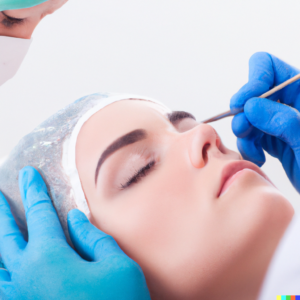How to start a plastic surgery practice?Starting a plastic surgery practice can be an exciting and rewarding endeavor. It is important to understand the steps necessary to make sure your practice is successful. Plastic surgery requires specialized education and training, so it is important to consider the educational requirements before starting your practice. Additionally, you will need to carefully consider legal requirements and funding options. This article provides an overview of the steps required to start a successful plastic surgery practice.
Education Requirements
In order to open a plastic surgery practice, you must have completed medical school and completed a residency program in plastic surgery. You must also be board certified in the specialty of plastic surgery by the American Board of Plastic Surgery (ABPS). Additionally, you may need additional certifications or licenses depending on the state where you plan to operate your business.
Starting a successful plastic surgery practice requires careful planning and consideration of several factors including: business model, business plan, financial plan, services offered and pricing.
Step 1: Choose a Business Model for Your Business
When starting your plastic surgery practice, it is important to decide what type of business model you will use. Options include solo practitioner, limited liability company (LLC), professional association or partnership. Each has its own advantages and disadvantages, so it is important to consider the pros and cons of each option before making a decision.
Step 2: Develop Your Plastic Surgery Business Plan:
Once you have chosen your business model, it is important to develop a business plan. This should include your business goals, marketing plan, competitor analysis, business location, legal requirements and financial plan. Additionally, you should consider whether or not you need employees.
Plastic Surgery Practice Goals:
When developing your business plan be sure to include clearly defined goals for your practice. These goals should be realistic and achievable in order to ensure success. Here are a some goals to keep in mind:
- Provide exceptional patient care and satisfaction, delivered with compassion and respect.
- Maintain a safe and comfortable environment for patients and staff alike.
- Utilize the latest technology and best practices to achieve superior outcomes.
- Educate patients on the risks and benefits of plastic surgery procedures.
- Maintain strong relationships with referring physicians and other healthcare providers.
- Invest in personnel training and development to ensure long-term growth and success.
- Use a comprehensive marketing strategy to attract new patients and grow the practice.
- Offer competitive pricing and payment plans to make plastic surgery procedures more accessible.
- Stay abreast of industry trends and advancements to provide the best care possible.
- Foster a culture of innovation, collaboration, and continuous improvement.
Plastic Surgery Marketing Plan:
A good marketing strategy is essential for any successful business. You should develop a comprehensive plan that includes both online and offline strategies such as website design, search engine optimization (SEO), social media marketing, traditional advertising methods and more.
Example:
- Establish a website and social media presence to attract new patients.
- Develop content marketing strategies to educate potential patients on plastic surgery.
- Run targeted digital and traditional advertising campaigns.
- Leverage search engine optimization, pay-per-click, and other online marketing tools.
- Utilize email marketing, newsletters, and other direct communication strategies.
- Sponsor events and seminars to build awareness in the community.
- Cultivate relationships with referring physicians and other healthcare providers.
- Analyze and track results to gauge the effectiveness of marketing initiatives.
- Participate in online forums, industry groups, and other online communities.
- Utilize patient reviews, testimonials, and referrals to boost credibility.
Plastic Surgery Practice Competitor Analysis:
It is important to research potential competitors in the local area before opening a plastic surgery practice. This will help you understand the market better and develop strategies to differentiate yourself from the competition.
- Evaluate the market size and potential for growth.
- Research the competition to identify their strengths and weaknesses.
- Analyze pricing strategies and payment plans.
- Identify areas of opportunity to differentiate the practice.
- Investigate the quality of services and patient satisfaction levels.
- Assess the competition’s marketing efforts, including digital presence and advertising.
- Review customer feedback and reviews to identify areas of improvement.
- Monitor changes in the industry and competitor activity.
- Analyze the competition’s financials to understand their profitability.
- Develop strategies to capitalize on the competition’s weaknesses.
Choose a Business Location:
Choosing an appropriate location for your plastic surgery practice is essential for success. Consider factors such as cost of rent or mortgage payments, local competition, access to public transportation and other amenities.
Plastic Surgery Practice Legal Requirements:
Before opening your practice, it is important to make sure you comply with all local, state and federal laws. This includes obtaining the necessary business permits and licenses as well as ensuring compliance with health and safety regulations. Additionally, you will need to register your business name with the appropriate agency in your state.
Once you have complied with all legal requirements, you will need to register your business with the appropriate agency in your state. This will allow you to legally operate a plastic surgery practice.
Example:
- Comply with local, state, and federal laws regarding the practice of medicine.
- Obtain the necessary licensure and certifications to practice medicine.
- Establish a secure and compliant system for storing patient data.
- Develop a privacy policy to protect patient information.
- Comply with HIPAA regulations and other healthcare standards.
- Draft contracts, waivers, and other legal documents as needed.
- Understand and adhere to relevant advertising laws and regulations.
- Maintain adequate liability insurance to protect the practice.
- Develop a comprehensive risk management plan.
- Stay current on the latest legal and regulatory developments in the industry.
Get a Business Tax ID Number:
You will also need to obtain a tax identification number for your business from the Internal Revenue Service (IRS). This number is used for filing taxes and other purposes.
Open a Business Bank Account:
It is important to open a separate bank account for your plastic surgery practice in order to keep personal and business finances separate. This will make it easier to manage your finances and keep track of expenses.
Get Business Insurance:
You should also consider purchasing insurance for your plastic surgery practice in order to protect yourself from potential lawsuits or other liabilities.
Does Your Business Need Employees?
Depending on the size of your practice, you may need to hire employees. This will require additional paperwork and compliance with employment laws.
Financial Plan:
When developing your financial plan, it is important to consider start-up costs, monthly operating costs and annual operating costs. Additionally, you should include a cash flow statement to ensure your practice is financially viable.
Typical Equipment:
1. Operating Room Equipment: Operating tables, lights, anesthesia machines, monitors, and other necessary equipment for performing surgery.
2. Sterilization Equipment: Autoclave, sterilization trays, and other necessary tools for sterilizing surgical instruments.
3. Exam Room Equipment: Exam tables, exam chairs, stools, and other necessary items for examining patients.
4. Cosmetic Injectables: Botox, dermal fillers, and other aesthetic injectables to use for cosmetic treatments.
5. Surgical Instruments: Needles, scalpels, forceps, and other necessary items for performing plastic surgery.
6. Recovery Room Equipment: Recovery beds, recliners, and other necessary items for helping patients recover from surgery.
7. Imaging Equipment: Digital X-ray, ultrasound, and other imaging equipment for diagnosing and treating patients.
8. Office Furniture: Desks, chairs, filing cabinets, and other necessary items for running a plastic surgery practice.
9. Medical Supplies: Gauze, sutures, dressings, and other necessary items for treating patients.
10. Safety Equipment: Gowns, gloves, masks, and other necessary items for ensuring everyone’s safety in the operating room.
Start-Up Costs:
Start-up costs can include lease or purchase of equipment, office furniture and supplies, legal fees and more.
Lease/Rent: $3000 – $20,000
Furniture/Equipment: $10,000 – $50,000
Licensing/Permits: $500 – $5,000
Insurance: $2,000 – $10,000
Marketing Materials: $500 – $2,000
Professional Fees: $500 – $5,000
Staff Salaries: $10,000 – $30,000
Miscellaneous Expenses: $2,000 – $10,000
Total: $30,000 – $122,000
Monthly Operating Costs:
Monthly operating costs can include rent or mortgage payments, utilities, insurance premiums and employee salaries.
Example:
Lease/Rent: $3000 – $20,000
Utilities: $1000 – $2000
Insurance: $1000 – $3000
Marketing: $500 – $1,000
Professional Fees: $200 – $500
Staff Salaries: $20,000 – $55,000
Miscellaneous Expenses: $500 – $2,000
Total Monthly Operating Costs: $26,200 – $79,500
You should calculate the total cost of all monthly expenses in order to determine the minimum amount of money needed for operation each month.
Annual Operating Costs:
It is also important to consider the annual operating costs for your plastic surgery practice in order to ensure long-term success. This includes expenses such as marketing campaigns, continuing education courses and other professional services.
Here is an example Annual Operating Costs:
Annual Operating Costs:
Lease/Rent: $36,000 – $240,000
Utilities: $12,000 – $24,000
Insurance: $12,000 – $36,000
Marketing: $6,000 – $12,000
Professional Fees: $2,400 – $6,000
Staff Salaries: $240,000 – $660,000
Miscellaneous Expenses: $6,000 – $24,000
Total Annual Operating Costs: $312,400 – $992,000
Step 3: Choose Your Business Services
When starting a plastic surgery practice you must decide which services you will offer. Common services include breast augmentation, liposuction and rhinoplasty among others. Consider the needs of your local market when deciding which services to offer. Check below for examples:
- Cosmetic Surgery: Offering a variety of procedures such as facelifts, liposuction, breast augmentation, and more.
- Reconstructive Surgery: Helping to restore form and function to areas of the body that have been damaged or altered.
- Non-Surgical Treatments: Offering treatments such as Botox, dermal fillers, chemical peels, and more.
- Skin Care Services: Providing various skin care products and services such as facials, microdermabrasion, and more.
- Patient Education and Support: Helping patients understand their options and providing support throughout the process.
- Aftercare Services: Offering follow-up care and monitoring to ensure optimal results.
- Medically Supervised Weight Loss: Offering dietary counseling, exercise programs, and other services to help patients achieve their weight loss goals.
- Medical Spa Services: Offering spa treatments such as body wraps, facials, and massage.
- Financing Options: Providing payment plans and other financing options to help patients afford their procedures.
- Telemedicine Services: Offering virtual consultations, follow-ups, and other services to make it easier for patients to access care.
Step 4: Set Your Business Prices
Setting your business prices is an important step in the process of starting a plastic surgery practice. You should consider factors such as cost of supplies and labor, overhead costs, competition and potential profit margins when setting your prices. Additionally, you should research insurance reimbursement rates for procedures you plan to offer in order to ensure your fees are competitive.
Example of Business Prices:
Breast Augmentation: $6,000
Liposuction: $3,500
Rhinoplasty: $4,250
Botox: $250 per area
Dermal Fillers: $600 per syringe
Chemical Peels: $150-400
Facials: $75-150
Microdermabrasion: $100-200
Body Wraps: $75-125
Medical Weight Loss Program: $400-800
Step 5: Find Your Potential Customers or Clients
Once you have decided on the services you will offer and the prices you will charge, it is time to find potential customers or clients. This can be done through traditional marketing methods such as print advertising or online strategies such as social media marketing or search engine optimization (SEO). Additionally, you can reach out to local medical professionals for referrals.
Example:
For example, if you are located in a large city with several hospitals and medical centers, contact their administration offices to inquire about making yourself available for referrals from their physicians.
Step 6: Build Your Business
Once you have established your plastic surgery practice, it is important to continue to build your business. This includes developing relationships with other medical professionals, investing in continuing education and attending industry events. Additionally, you should consider offering special promotions or discounts in order to attract new customers or clients.
Conclusion
Starting a plastic surgery practice is no easy task. It requires careful planning, research, and foresight to make sure that you can provide quality service while also having a reliable income stream. To be successful in your venture, it’s essential that you develop an appropriate business model and model for the type of practice you are going to operate; determine how much capital is necessary to start up the business; educate yourself on legal requirements; consider hiring employees if applicable; think carefully about pricing models and product offerings; find potential clients through effective marketing plans and build your surgical team with experienced professionals while adhering to safety regulations.
With this guidance in mind, you will have the knowledge and skillset needed for starting a successful plastic surgery practice.
We hope this blog post “How to start a plastic surgery practice?” has helped clear up any confusion you may have had. If you have any further questions, feel free to reach out to us and we would be happy to help! We are not financial advisors or lawyers. This content is for educational purposes only and you should always consult a professional before beginning any business venture. Make sure you also check other sources.
Hey, check out:
Today sponsors are Local Handyman Tulsa, Sprinkler Repair Long Island, Mailbox Repair Tulsa, Chester County Towing Services, and Hutto Tx Roof Repair. Always providing the best services in town.





